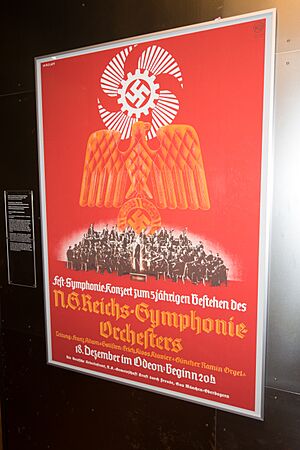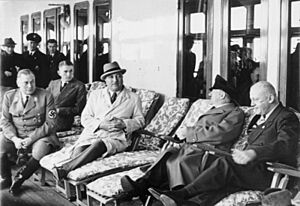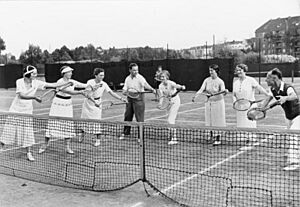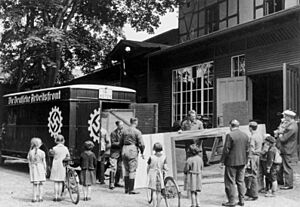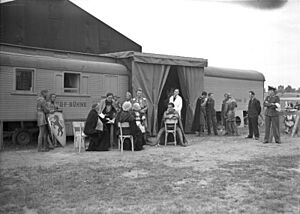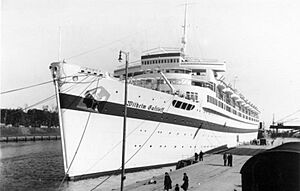Strength Through Joy facts for kids
|
Kraft durch Freude
|
|
 |
|
| Formation | 27 November 1933 |
|---|---|
| Dissolved | 8 May 1945 |
| Type | Party organization |
| Purpose | Promote Nazism through subsidized leisure activities and holidays, and creation of Volksgemeinschaft |
| Headquarters | Berlin |
| Location | |
| Leader | Robert Ley |
|
Parent organization
|
German Labour Front |
|
Staff
|
7,000 (1939) |
|
Volunteers
|
135,000 (1939) |
Strength Through Joy (in German: Kraft durch Freude or KdF) was a special group in Nazi Germany. It was part of the German Labour Front, which was the main worker organization at the time. KdF started in November 1933.
Its main goal was to show Germans the good things about the Nazi way of life. It also helped prepare Germany for war by making people feel good about their country. KdF tried to make up for low wages and the loss of workers' rights. It offered fun activities and spread government ideas. By 1939, it was the biggest travel company in the world.
KdF had different parts, each with its own activities. These included sports at factories, art shows, cheap concerts, and popular holidays and cruises. One big part was called Beauty of Labour. This group worked to make workplaces cleaner and better. KdF helped improve many factories and sports places in the 1930s.
KdF wanted to bring people from different social classes together. It made fun activities, usually for richer people, available to everyone. It also helped Germany's travel industry grow a lot before World War II started. In 1934, 2.3 million people went on KdF holidays. By 1938, this number grew to 10.3 million. When the war began in 1939, most of KdF's programs stopped. Some big projects, like the Prora holiday resort, were never finished.
Contents
How KdF Was Organized
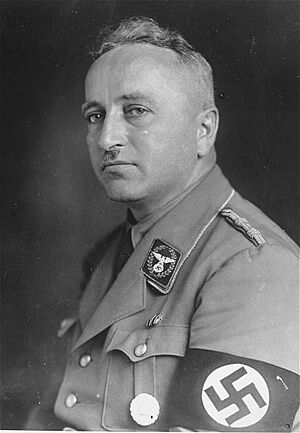
On November 27, 1933, Robert Ley announced Strength Through Joy. It was a part of the German Labour Front. Its goal was to let Germans enjoy activities like cruises and owning cars. These things used to be only for the wealthy.
The government worried that raising wages would slow down their plans to build up the army. So, they decided to improve people's lives in other ways. They wanted to make people like the Nazi government more. The program was paid for by taking money from workers' wages.
By offering these nice things, the government hoped to unite different social classes. They wanted to build a 'people's community'. This meant everyone would work together for the country. A key part of this community was having healthy people. This would make them fit for military service and work. The government also believed that if workers had enough free time and clean workplaces, they would be happier and work better. This was important for preparing for war. At first, KdF focused on evening and weekend activities. But after train trips became popular, tourism became a big focus.
KdF's Different Departments
KdF had several different departments.
Beauty of Labour
The Beauty of Labour (Schönheit der Arbeit) department focused on making workplaces better. This included improving cleanliness and reducing noise.
Sports Office
The Sports Office (Sportamt) organized sports like tennis and skiing. These sports were often too expensive for working-class people before. This office wanted to bring 'everyday joy' and improve people's health. KdF really wanted Germans to be physically strong. They set up exercise classes and gymnastics on weekends and after work. They also had skiing and hiking trips. They encouraged bosses to provide sports places and gear at work.
Adult Education Office
The Adult Education Office (Volksbildungswerk) was led by Fritz Leutloff. It taught Germans about culture and art. By 1936, this office worked closely with the Reich Chamber of Culture. They planned to make KdF a cultural group, but this did not happen.
Leisure Time Office
The Leisure Time Office (Amt Feierabend) helped workers go to theaters and concerts. It set up local events and offered cheaper tickets. It also organized concerts and events right in factories. This office focused on fun ways to spend free time.
Travel, Hiking, and Holidays Office
The biggest and most successful department was the Office for Travel, Hiking, and Holidays (Amt Reisen, Wandern, und Urlaub). It was led by Bodo Lafferentz. For the first time, workers could travel far away. This happened because they offered discounts on travel and tour packages. Thousands of Germans went on holidays before 1939.
What KdF Did
After it started, KdF offered many activities at low prices. These included concerts, theater trips, weekend getaways, and longer holidays. Workers could enter KdF contests and win trips for their families. Many events happened after work or on weekends. The government wanted to create a good environment and encourage people to support the state.
In the Workplace
KdF quickly grew into one of Germany's largest groups. It took ideas from an Italian group called Dopolavoro ('After Work'). KdF also worked to improve conditions right in the workplace through its Beauty of Labour department.
Wardens were placed in every factory with more than 20 workers. They worked to make workplaces cleaner. This included providing toilets, locker rooms, and washing areas. They also tried to improve air quality and reduce noise. The government offered tax breaks to encourage these changes. By 1938, conditions in 34,000 workplaces were much better. Workers often did these improvements themselves during unpaid overtime.
KdF believed sports would make people healthy and positive. So, the Sports Office started physical education for workers. By 1936, sports training was part of factory life. Workers under 18 had to exercise during their workweek. The Sports Office also pushed bosses to build sports areas at work, like tennis courts. By 1939, about 3,000 sports facilities were built. Over 12 million sports classes were organized. KdF wanted workers to be strong and healthy for the 'people's community'.
The Leisure Time Office and Adult Education Office wanted to teach adults about arts and culture. They also wanted to make sure people spent their free time well. They held art shows, concerts, and cultural events inside factories. This made it easy for workers to attend. Art shows featured only German artists. Plays, musicals, and concerts were organized. Tickets were very cheap or free. Some art shows displayed art made by workers. Sometimes famous musicians like Wilhelm Furtwängler led the Berlin Philharmonic orchestra. Over time, most performances became about government ideas.
At Home and Abroad
The Sports Office organized many sports events and classes. In summer, they offered horse riding, sailing, and swimming. Track and field events were popular. Gymnastics became very popular for German women. In winter, KdF organized skiing, ice skating, and winter hiking. Most events were on weekends. Volunteers, often unpaid teachers, taught exercise classes. KdF used local school gyms or halls. They offered 'open courses' for 30 pfennings for 90 minutes. You didn't need to sign up ahead of time. 'Closed courses' cost 80 pfennings for 90 minutes and required signing up. These covered sports like boxing and golf. Early KdF activities often avoided competition. This was to focus on joy and health, and to encourage cooperation. In 1939, KdF won the Olympic Cup.
The Leisure Time Office offered many activities and discounts. They had cheaper tickets for movies, musicals, and plays in cities. In rural areas, KdF used special buses called Theaterzüge. These buses had film projectors and speakers. They also set up plays using mobile stages. The Great Theatre in Berlin was renamed the 'Theatre of the People'. It became KdF's official theater. Other KdF theaters opened in big cities. The Adult Education Office also used these theaters for government films. KdF hired performers and had its own orchestras. By 1938, KdF supported plays like As You Like It by William Shakespeare. Later, most performances were about government ideas. When the war became very serious, most performers worked to entertain soldiers.
The Office for Travel, Hiking, and Holidays offered many discounted trips. These ranged from day trips to holidays lasting weeks. Travelers went by train and bus within Germany or to occupied areas. Activities included hiking and swimming. Hotel owners and local businesses often made more money from the tourists. The German National Railway also benefited. Popular places for longer holidays included the Alps and the coasts. But most trips were overnight or weekend trips. Many KdF travelers complained about their trips. They noted poor travel conditions and little free time because activities were strictly planned.
Most famously, the office offered cheap cruise trips. At first, cruises were not planned. But they were so successful that six large ships were built just for KdF. These included the MV Wilhelm Gustloff and the MV Goya. Six more ships were rented. These were the first ships built only for cruises. They were called the KdF fleet. The MV Robert Ley was the most important ship.
These cruises helped spread Nazi ideas around the world. KdF travelers were expected to act well and dress simply. Ship events included costume parties, talks about politics, and shows about German traditions. The government had people on the ships pretending to be passengers. These people watched how others behaved. Cruises were sometimes prizes in KdF contests. They were also very affordable. An 18-day trip to Madeira cost 120 Reichsmarks. This was about four weeks' average pay. A seven-day trip to Norway cost about 50 Reichsmarks. Even though cruises were cheap, most people on them were from the middle class, not working-class people.
After Germany invaded the Soviet Union, tourism stopped. KdF focused on activities within Germany and entertaining soldiers. By this time, KdF had sold over 45 million package tours and trips. This meant over 700,000 Germans had traveled.
Wartime Activities

KdF created 'troop-care units' in 1935. After the invasion of Poland in 1939, a new department was made for 'Caring for the Troops'. Hans Hinkel was put in charge. These units were like the USO in the United States. They used portable stages and hired performers like musicians and actors. Many performers were not very experienced. By late 1941, it was a huge program. Troop-care units had put on over 300,000 shows everywhere the war was fought, even in Africa. Hinkel said these units were as important as the army. He said soldiers and artists were connected through their loyalty to Hitler. He called them "an essential part of modern war." They also worked to keep soldiers healthy and happy. They offered art shows and sports. These shows were not just for the army. They also performed for guards in concentration camps and for Germans living in occupied areas.
Several KdF cruise ships were taken by the navy. They were changed into hospital ships. The Robert Ley was taken in August 1939. It became a hospital ship after only six months of use. The ship was changed several times for different uses during World War II. It was bombed in Hamburg in March 1945. The wreckage stayed floating until June 1947, then it was taken to the UK and taken apart. The MV Wilhelm Gustloff was taken in September 1939. It was named Lazarettschiff D and became a hospital ship. In November 1940, its medical gear was removed, and it became a barracks ship. It was used to carry people during Operation Hannibal. The Lazarettschiff D sank on January 30, 1945, while returning to Germany. About 9,934 people died. It was one of the deadliest sea disasters in history.
The People's Car

KdF's biggest plan for German workers was to make an affordable car. This car was called the KdF-Wagen. Later, it became the Volkswagen Beetle. Volkswagen means 'People's Car' in German. This project started when Hitler asked engineer Ferdinand Porsche to design a cheap car.
When German car companies could not make the Volkswagen for 1,000 Reichsmarks or less, the German Labour Front took over the project. Porsche then built a new Volkswagen factory in Fallersleben. This cost a lot of money. Part of the money came from the German Labour Front's savings and fees paid by its members.
The Volkswagen was sold to German workers through a payment plan. Buyers made payments and put stamps in a savings book. When the book was full, they could get the car. But because of the war, no regular person ever received a KdF-Wagen. After the war, Volkswagen did give some customers a 200 DM discount for their stamp-books. The Beetle factory was mostly used to make the Kübelwagen, which was like the American Jeep. The few Beetles that were made went to government officials and military leaders.
Propaganda Efforts
The radio was a very important tool for spreading government ideas in Nazi Germany. Joseph Goebbels understood this and wanted to use it. He asked engineer Otto Griessing to create the 'people's receiver', or 'people's radio'. The first model, the VE301, was shown in August 1933. It cost 76 Reichsmarks, which was about two weeks' average pay.
A cheaper model, the DKE38, was made later. It was sometimes called the "Goebbels' snout" by Germans. This model was used as the basis for a KdF-branded radio. It cost 35 Reichsmarks, and people could pay in installments. This gave poorer Germans access to radio for the first time. These radios were made cheaply and had a short reception range. This was fine as long as they could receive the main German radio stations. It is thought that the short range was on purpose. Listening to non-German radio stations became a crime. Punishments ranged from fines and losing your radio to, later in the war, being sent to a concentration camp or even death.
Several films were made to promote KdF. They usually showed workers doing the many activities offered by the group. For example, one film showed how factories had improved. Groups were shown exercising, walking around company grounds, and borrowing books from the company library.
Images for kids
See also
 In Spanish: Kraft durch Freude para niños
In Spanish: Kraft durch Freude para niños
- German labour law
- Volksflugzeug ('People's Aircraft')



